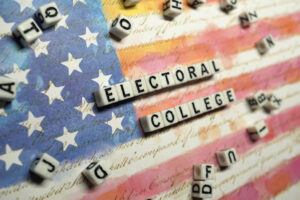What Would Be Required to Change How Presidents Are Elected?

The unique method by which the United States elects a president—the Electoral College—has come under increasing scrutiny over the last 20 years, as two candidates who lost the popular vote carried the electoral college and became president. In the 2016 campaign, the person who became president had nearly 3 million fewer votes than his rival. Before the late votes were counted in 2020, it looked as if it might happen again and by an even wider margin.
The apparent inconsistency between the results of the popular vote and the Electoral College has led to renewed calls for its abolishment. Originally proposed as a compromise between those who wanted the president elected by a popular vote and those who wanted the president elected by the Senate, the Electoral College comprises individuals who are appointed according to terms established by state legislatures. Each state is allotted the number of electors equal to the total number of Senators and Representatives it has in the United States Congress.
Arguments For and Against the Electoral College
Though most of the public outcry seems to be in favor of ending the Electoral College, there are many who believe it serves an important purpose. Many believe it to be an effective guard against election fraud. Others say that the electoral college minimizes the likelihood that a candidate with only regional appeal will win, as there are not enough electoral votes in any region to allow that.
Those seeking to abolish the Electoral College argue first and foremost that it is essentially an undemocratic process that leaves millions feeling as if their vote is meaningless. For example, in a state like Alabama, which votes heavily Republican, a person voting for a Democratic candidate may have little incentive to cast a vote. The same thing holds true for Republicans in California. Accordingly, critics of the Electoral College contend that abolishing it will lead to greater voter turnout.
What Would Be Required to Abolish the Electoral College
Because the Electoral College is established by the U.S. Constitution, the only way to terminate its use is through a constitutional amendment. Though such an amendment has never been sent to the states for ratification (it would require approval by 38 states), more than 700 proposals have been introduced in Congress over the past 200 years. Before such an amendment could be ratified by the states, it must be approved by a two-thirds majority in both houses of the United States Congress. No proposal to amend or abolish the electoral college has ever received that approval, and it is particularly unlikely with the current political landscape, in which it is virtually impossible to get a two-thirds majority in either house.
There may be another avenue, however, for ensuring that the winner of the popular vote also wins the Electoral College. It’s known as the National Popular Vote Interstate Compact. Each state that signs on to the compact agrees to give all their electoral votes to the candidate who gets the most votes nationwide, regardless of what happens in that individual state. Thus far, 15 states and the District of Columbia have joined the compact, accounting for 196 electoral votes. Nearly a dozen other states are considering adopting the compact, including Texas, Ohio, and Pennsylvania, which would bring the tally to 294, more than the 270 required to elect a president. If enough states participate, the Compact will ensure that the winner of the popular vote will also win the Electoral College. The Electoral College would not be abolished, but it would always be in line with the popular vote.
